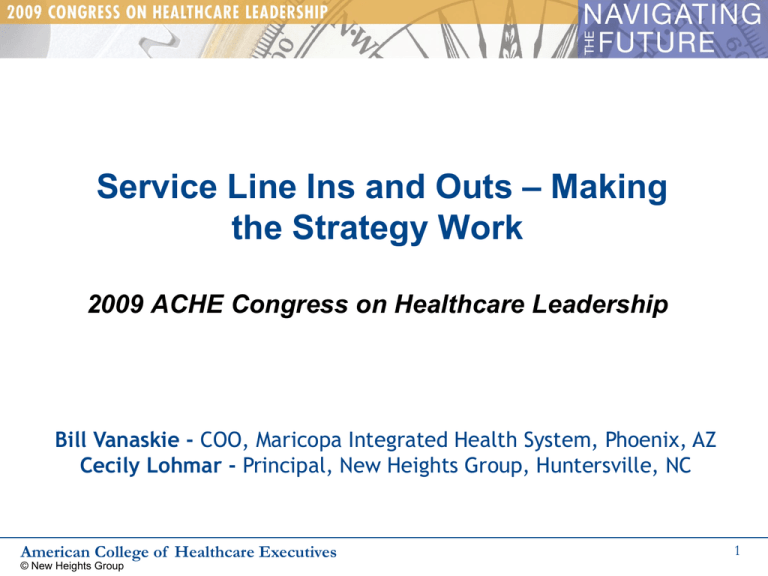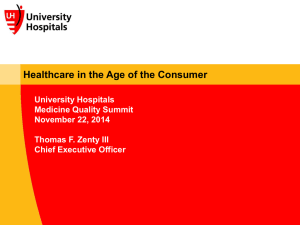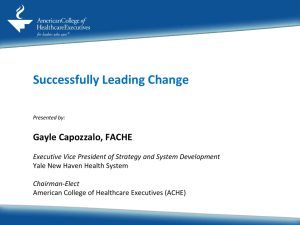Service Line Marketing
advertisement

Service Line Ins and Outs – Making
the Strategy Work
2009 ACHE Congress on Healthcare Leadership
Bill Vanaskie - COO, Maricopa Integrated Health System, Phoenix, AZ
Cecily Lohmar - Principal, New Heights Group, Huntersville, NC
American College of Healthcare Executives
© New Heights Group
1
Session Objectives
• Understand the challenges in implementing service line
management in healthcare and its implications on the
organization
• Learn how to determine the most appropriate approach to
service line management for your organization
• Identify strategies for addressing the key barriers to
successful implementation of service lines
American College of Healthcare Executives
© New Heights Group
2
The Challenges
• Fully understanding the strategy and implications
• Focusing on the right structures and services
• Engaging physicians
• Integrating service lines with traditional structures and
functions
Source: 2008 survey of strategy executives sponsored by New Heights Group/ Healthcare Forum for Strategy
American College of Healthcare Executives
© New Heights Group
3
Understanding the Service
Line Strategy
American College of Healthcare Executives
© New Heights Group
4
The Fundamentals
• An organizational model borrowed from
other industries (think P&G, Saturn)
More closely aligns operating units with the
customer base (patients)
Traditional hospital model aligns with staff and
physicians
• Has been adapted for use in healthcare
In its adaptation, basic intent has been forgotten:
• To design, organize, and manage a distinct area of the
enterprise to create a product of greater value
American College of Healthcare Executives
© New Heights Group
6
Foundation
President and Chief
Executive Officer
Strategic
Planning
Corporate Development
Office of General
Counsel
Chief Operating Officer
Nursing
Professional
Services
Support
Services
Cardiac/
Surgical
Radiology
Materials
Management
Women’s
Health
Labs
Food
Services
Medicine
Oncology
Medical
Records
and Archives
Ortho and
Neuro
Quality and
Medical Affairs
Clinical
Effectiveness
Treasury
Hospital
Effectiveness
Internal
Audit
MD Staff Office
and
Research
Financial
Planning
and
Analysis
Patient Escort
and Security
Psychiatric
Services
Emergency
Services
Nursing
Development
Property
Management
Therapeutic
Services:
•Rehabilitation
•Respiratory
Therapy
Facilities and
Engineering
Biomedical
Engineering
In House
Agency
Ambulatory
Care
Services
American College of Healthcare Executives
© New Heights Group
Program
Planning
and
Execution
Program
Administration
Marketing
and
Communications
Environmental
Services
Pharmacy
Case
Management
Services
Finance
Financial
Operations
and
Admitting
Physician
Support
and Outreach
Human
Resources
Organization
Development
Chief
Information
Officer
Information
Systems
HR Planning
and
Communications
Personnel
Administration
Planning and
Market
Research
The traditional healthcare silos
established to support the staff,
not the patients
7
President and CEO
VP of Corporate Development
VP of Systems and Finance
VP of Managed Care
VP of Medical Affairs
Executive VP and COO
VP of Human Resources
Director of Cardiology
Services
VP of Facilities Development
Director of Oncology
Services
VP of Support Services
Director of Behavioral
Health Services
VP of Patient Care Services
Director of Women/
Children Services
Service lines bring a different mix of
staff together to support patients
American College of Healthcare Executives
© New Heights Group
Director of Long Term Care
8
When is a Service Line Strategy For You?
Organizational
Needs
Functional
Service Line
Strategic Orientation
Departments
Services/patients
Competitive
Orientation
Low
High
Control over
resources, costs,
and performance
Low
Moderate
Continuum of care
Low
High
Rapid decisionmaking
Low
High
Stable
Changing
Flexibility
American College of Healthcare Executives
© New Heights Group
9
What is Your Objective?
• Greater focus on “mission critical” services - those services of most
importance to organizational success (core service lines)
• Strategic ‘watchdog’ to monitor and respond to market changes
• Enhanced operational efficiency
• Greater alignment with physicians
• More appropriate allocation of organizational resources – human
and capital
• Expedited decision making; enable organization to assess
vulnerable areas and adjust rapidly to changes in submarkets
• Keep up with the other guy
American College of Healthcare Executives
© New Heights Group
10
What Constitutes a Service Line?
• In practice, no consistent definition applied.
Delivery settings (rehabilitation) – do stroke patients go through
similar continuum as sports patients?
Demographic populations (women’s) – are needs of young
women at all similar to those of older women
Revenue centers (surgery) – is the continuum of care even similar
for trauma as it is for pediatric ENT?
• A patient population that travels through the same
continuum of care; typically defined by group of diagnoses
(cardiovascular)
Beginning to see subgroups of service lines develop (thoracic,
vascular)
American College of Healthcare Executives
© New Heights Group
11
Selecting the Service Line Model
That’s Right for You, Not Them
American College of Healthcare Executives
© New Heights Group
12
Service Line Models - The Continuum
High
Implementation
Challenge
Service line organization
Service line management
Consumer
industry
models
Service line leadership
Service line marketing
Hybrids
adapted for healthcare
Low
Low
High
Ability to Create/Add Value
American College of Healthcare Executives
© New Heights Group
13
Service Line Marketing
CEO
•
•
Focus: marketing only
No authority/ accountability
across functional areas or
departments
Marketing
SERVICE LINES
Pros
Easy to implement
Minimal culture change needed
Creates market perception of
coordination
American College of Healthcare Executives
© New Heights Group
Operations
Nursing
Ancillaries
Finance
IT
Budget
Managed Care
Cons
No ‘there, there’
No mechanism for delivering on
market image
Potential to backfire – promise more
than deliver
14
Jones Hospital
Marketing
Leadership
Management
Organization
Entrenched in
traditional culture
Strong traditional
culture; focus on
departments, not
patient groups
Traditional culture,
but starting to focus
on market vs.
internal departments
Market oriented
culture; adapts easily
to change
Strategic
Orientation
Operational vs
strategic
orientation
Begin thinking
strategically about
service lines
Achieve dominance
in key service lines
Manage the healthcare
dollar and patient
experience
Management
Leadership
Equate service
lines with
advertising
Strong, oriented
around functional
departments
Management team
understands and
‘thinks’ service lines
Very strong, visible,
active
Little to none
Potential, but not
yet identified
Yes
Yes, strong
Market
Dynamics
Competition not
strong; visibility is
primary need
Strategic thinking
needed to reverse
volume trends
Key service line
competitive;
consumer
expectations rising
Competitive, need for
differentiation strong
Consumer
expectations high
Information
Systems
Limited ability to
analyze individual
service line
performance
Basic financial and
market performance
available at service
line level
Full P&L available by
service line
Information systems
must cross campuses
and departments
Culture
Physician
Leadership
American College of Healthcare Executives
© New Heights Group
15
Critical Success Factors –
Service Line Marketing
• Do
Validate that your product is worth marketing
Prove you can deliver on any promises
Try to get at least one physician behind your efforts
See a longer vision – is this the endgame or a means to a different end?
Seek to understand your service line market before your campaign
• Don’t
“Dump” this in marketing’s lap; leadership must still own service and
strategy
Market without measurable performance objectives – volume, payer mix,
etc.
American College of Healthcare Executives
© New Heights Group
16
Service Line Leadership
•
•
•
Service line leaders are champions and thought leaders
Matrix relationships across organization
Support by planning, marketing, finance, recruitment, other staff
functions
CEO
Service Lines
Service Line Support
Planning/Marketing
Finance
Pros
Culture change not significant
Good stepping stone to advanced
structure
Creates momentum and visibility
Provides physicians with ‘go to’ person
American College of Healthcare Executives
© New Heights Group
Nursing
Ancillaries
Cons
No authority to affect operational change
Reliance on matrix relationships
challenging in a silo culture
Risk losing physician interest without
operational change
Operations ‘trump’ strategy
17
Carnegie Hospital
Marketing
Leadership
Management Organization
Culture
Entrenched in
traditional culture
Strong traditional
culture
Traditional culture;
not resistant to
change
Culture adapts easily
to change
Strategic
Orientation
Operational vs
strategic
orientation
Begin thinking
strategically
about service
lines
Achieve dominance
in key service lines
Manage the
healthcare dollar and
patient experience
Managemen
t Leadership
Equate service
lines with
advertising
Strong, oriented
around functional
departments
Management team
understands and
‘thinks’ service lines
Very strong, visible,
active
Physician
Leadership
Little to none
Potential, but not
yet identified
Yes
Yes, strong
Market
Dynamics
Competition not
strong; visibility is
primary need
Strategic thinking
needed to reverse
volume trends
Key service line
competitive;
consumer
expectations rising
Competitive, need for
differentiation strong
Consumer
expectations high
Information
Systems
Limited ability to
analyze individual
service line
performance
Basic financial
and market
performance
available at
service line level
Full P&L available
by service line
Information systems
must cross
campuses and
departments
American College of Healthcare Executives
© New Heights Group
18
Service Line Management
CEO
•
Service line managers have accountability
over operational departments affecting
their service line
•
Service line managers both operational
and strategic leaders
•
Typically report directly to COO or CEO
•
Senior leadership active support critical
COO
VP, HR
Dir, Cardiology
VP Facilities
Dir, Oncology
VP Patient Care
Dir, Women's
Pros
Cons
Single accountability for performance
enables greater focus
More responsive to change, and more aware
of market needs
Physicians and consumers have clear
‘go to’ person
Significant culture change within organization
Difficult to manage both service line and
functional departments
American College of Healthcare Executives
© New Heights Group
19
St. Somewhere Health System
Marketing
Leadership
Management
Organization
Culture
Entrenched in
traditional culture
Strong traditional
culture
Traditional culture;
not resistant to
change
Culture adapts easily
to change
Strategic
Orientation
Operational vs
strategic
orientation
Begin thinking
strategically about
service lines
Achieve dominance
in key service lines
Manage the healthcare
dollar and patient
experience
Management
Leadership
Equate service
lines with
advertising
Strong, oriented
around functional
departments
Management team
understands and
‘thinks’ service lines
Very strong, visible,
active
Physician
Leadership
Little to none
Potential, but not
yet identified
Yes
Yes, strong
Market
Dynamics
Competition not
strong; visibility is
primary need
Strategic thinking
needed to reverse
volume trends
Key service line
competitive;
consumer
expectations rising
Competitive, need for
differentiation strong
Consumer
expectations high
Information
Systems
Limited ability to
analyze individual
service line
performance
Basic financial and
market performance
available at service
line level
Full P&L available by
service line
Information systems
must cross campuses
and departments
American College of Healthcare Executives
© New Heights Group
20
Cardiovascular Service Line Management
Executive Director
Administrative
Assistant
Director, Cardiac
Nursing
5WT, 5G, 5ET, CCU,
6D, 6T, CVSU, CV
Outcomes
Director, Invasive
Cardiology
CATH, EP, CNIL,
CPIU, Pre-Post Care,
CVOR
Director, Preventive
Cardiology
Administrator,
WS Cardiology
Preventive Cardiology,
Heart Failure Clinic,
Lipid Clinic, CV
Research
Kimel Park,
Kernersville,
Yadkinville, Wilkes
American College of Healthcare Executives
© New Heights Group
Project Manager,
Mobile Cath Lab
Medical Director,
Lipid Clinic
21
Service Line Organization
•
•
•
•
Complete organizational redesign
Functional departments become support to service lines;
no independent identities
Multiple campuses run by site administrator who ensures service line
needs are met on site
Senior leadership take on dual roles – site administrator and service
line leader
Pros
Shift entire culture often easier than mixing
traditional and service lines
Places emphasis on patient experience
rather than departments; fosters strong
consumer orientation
Aligns service-specific patient care
requirements across continuum
American College of Healthcare Executives
© New Heights Group
Cons
Culture shift difficult for many
Physicians – dual relationship with service
line leaders and site administrator
Structure only possible in a few organizations
Difficult to hold particular department
accountable for achieving broader goals
22
Health System
Leader
Cardiology
Pediatric
Oncology
PROS
• Service line teams are important in obtaining
institutional support from key players
• Avoids ambiguity over authority and
accountability
• Technical specialists with knowledge in one
area are brought together
• Scarce or expensive resources can be best
utilized
• Aligns service specific patient care
requirements across the continuum
American College of Healthcare Executives
© New Heights Group
OB / GYN
Ambulatory
Behavioral
Health
CONS
• Information systems overhaul needed to
support change
• Service line managers’ lack of authority over
physicians and functional departments limits
ability to increase revenues and control costs
• Relies on integrated systems to manage the
flow of information
• Changes medical staff structure
• Matrix structure often confusing
• Outpatient services can be difficult to fit in to
service lines and system structure
• Culture change VERY difficult
23
All Saints Medical Center
Marketing
Leadership
Management
Organization
Culture
Entrenched in
traditional culture
Strong traditional
culture
Traditional culture;
not resistant to
change
Culture adapts easily
to change
Strategic
Orientation
Operational vs
strategic
orientation
Begin thinking
strategically about
service lines
Achieve dominance
in key service lines
Manage the healthcare
dollar and patient
experience
Management
Leadership
Equate service
lines with
advertising
Strong, oriented
around functional
departments
Management team
understands and
‘thinks’ service lines
Very strong, visible,
active
Physician
Leadership
Little to none
Potential, but not
yet identified
Yes
Yes, strong
Market
Dynamics
Competition not
strong; visibility is
primary need
Strategic thinking
needed to reverse
volume trends
Key service line
competitive;
consumer
expectations rising
Competitive, need for
differentiation strong
Consumer
expectations high
Information
Systems
Limited ability to
analyze individual
service line
performance
Basic financial and
market performance
available at service
line level
Full P&L available by
service line
Information systems
must cross campuses
and departments
American College of Healthcare Executives
© New Heights Group
24
Focusing on the Right Things:
Portfolio Analysis
American College of Healthcare Executives
© New Heights Group
25
Components of a Portfolio Analysis
• Hard components:
Market assessment
Financial assessment
The foundation
• Soft components:
Operational
Quality
• Softer still
Physician leadership
Physician interest
American College of Healthcare Executives
© New Heights Group
Used in rating
services and
determining actions
and priorities
26
Market Assessment
Percent of total volume
indicates organization’s
reliance on service
Service Lines
CARDIOLOGY - Medical
GASTROENTEROLOGY - Medical
GENERAL MEDICINE - Medical
GYNECOLOGY - Medical
NEONATOLOGY - Medical
NEUROLOGY - Medical
NORMAL NEWBORNS - Medical
OB/DELIVERY - Medical
ONCOLOGY - Medical
ORTHOPEDICS - Medical
OTHER OB - Medical
PSYCH/DRUG ABUSE - Medical
PULMONARY - Medical
REHABILITATION
TRAUMA - Medical
UROLOGY - Medical
OTHER - Medical
% of
Hospital
Total
ALOS
CMI
Regional
Draw
Market
Size
Primary Primary Secondary Tertiary
Primary
Comparing ALOS against
regional/national norms provides some
indication of operating and quality
performance
American College of Healthcare Executives
© New Heights Group
Market Share
Projected Market
Growth (Growth in
Use Rates 2003-2009)
Compare case mix
index against
comparable
facilities – are we
seeing the same
patient types?
27
Market Assessment
Market size measured by use rates to
control for population size; compare
against regional and national rates to
see if discrepancies exist. Review
trends.
Reviewing regional draw
shows how far beyond service
area service draws from;
relevant for some orgs only.
Service Lines
CARDIOLOGY - Medical
GASTROENTEROLOGY - Medical
GENERAL MEDICINE - Medical
GYNECOLOGY - Medical
NEONATOLOGY - Medical
NEUROLOGY - Medical
NORMAL NEWBORNS - Medical
OB/DELIVERY - Medical
ONCOLOGY - Medical
ORTHOPEDICS - Medical
OTHER OB - Medical
PSYCH/DRUG ABUSE - Medical
PULMONARY - Medical
REHABILITATION
TRAUMA - Medical
UROLOGY - Medical
OTHER - Medical
% of ALOS
Hospital
Total
CMI
Market Share
Primary Primary Secondary Tertiary
Projected Market
Growth (Growth in
Use Rates 2003-2009)
Primary
Future opportunities can be found in use rate
changes due to ‘normalization’,
demographics, technology and other external
forces.
American College of Healthcare Executives
© New Heights Group
Regional
Draw
Market
Size
28
Financial Indicators
Other measures
may include
payor mix, %
government payor
Service Line
CARDIOLOGY - Surgical
OPEN HEART - Surgical
GENERAL SURGERY - Surgical
BARIATRIC SURGERY-Surgical
ENDOMETRIOSIS
GYNECOLOGY - Surgical
ONCOLOGICAL SURGERY - Surgical
NEUROSURGERY - Surgical
OB/DELIVERY - Surgical
OTHER OB - Surgical
ORTHOPEDICS - Surgical
TRAUMA - Surgical
UROLOGY - Surgical
measures
OTHER - Surgical
Contribution margin
financial performance before
overhead and indirect expenses.
American College of Healthcare Executives
© New Heights Group
Organ.
Reliance
Contribution
Margin
Profitability
Organizational reliance measures
percent of total net income attributed
to that service line.
29
Service Line Summary
% of
Hospital
Service Lines
Total ALOS
CARDIOLOGY - Surgical
4%
5.4
OPEN HEART - Surgical
2%
7.2
GENERAL SURGERY - Surgical
11%
4.9
BARIATRIC SURGERY-Surgical
0%
3.2
ENDOMETRIOSIS
3%
2.0
GYNECOLOGY - Surgical
1%
1.5
ONCOLOGICAL SURGERY 1%
3.8
Surgical
NEUROSURGERY - Surgical
5%
4.2
OB/DELIVERY - Surgical
3%
3.5
OTHER OB - Surgical
0%
1.5
ORTHOPEDICS - Surgical
12%
3.4
TRAUMA - Surgical
0%
12.5
UROLOGY - Surgical
2%
2.7
OTHER - Surgical
0%
1.9
Market
Size
CMI
3.3782
5.5691
1.9717
2.1498
0.9003
0.8573
1.4744
2.1697
0.7130
0.7156
1.6266
4.5105
1.1441
1.0980
Market Share
Regional
Draw Primary Primary Secondary Tertiary
64%
457
86%
81%
66%
60%
176
93%
88%
83%
71%
1,344
78%
47%
62%
80%
62
92%
67%
67%
70%
408
79%
51%
50%
64%
81
68%
48%
81%
76%
149
71%
52%
53%
65%
85%
75%
63%
39%
65%
63%
American College of Healthcare Executives
© New Heights Group
Projected
Market
Growth
(Growth in
Use Rates
2003-2009)
539
416
12
1,264
24
266
39
90%
78%
58%
85%
83%
72%
77%
89%
21%
0%
65%
55%
51%
60%
76%
17%
25%
75%
100%
90%
50%
Primary
9.3%
-11.4%
-11.4%
15.3%
-11.4%
-14.1%
6.2%
6.2%
19.4%
26.5%
0.0%
-11.4%
-11.4%
-16.7%
Percent Contriof Net
bution
Income
Income Margin Per Case
15.5%
39.0%
$2,371
19.5%
47.0%
$6,754
23.1%
40.9%
$1,483
2.6%
45.7%
$3,584
7.7%
52.9%
$1,585
1.5%
52.1%
$1,549
2.2%
44.0%
$1,487
9.6%
1.0%
0.1%
11.1%
0.8%
3.8%
0.1%
32.3%
37.9%
43.8%
31.5%
32.7%
44.4%
37.2%
$1,219
$261
$693
$613
$1,461
$1,235
$300
30
Pulling it Together
• Rating scale developed for each indicator
evaluated
• Services measured against each other
• Score provided for each rating
• Provides evaluation of both current and future
opportunities
• Serves as decision making guide, not
recommendation itself
American College of Healthcare Executives
© New Heights Group
31
Service Line Rating - Surgical
Market
Size
Service Lines
% of
Hospital
Total
ALOS
CMI
CARDIOLOGY - Surgical
OPEN HEART - Surgical
GENERAL SURGERY - Surgical
BARIATRIC SURGERY-Surgical
ENDOMETRIOSIS
GYNECOLOGY - Surgical
ONCOLOGICAL SURGERY - Surgical
NEUROSURGERY - Surgical
OB/DELIVERY - Surgical
OTHER OB - Surgical
ORTHOPEDICS - Surgical
TRAUMA - Surgical
UROLOGY - Surgical
OTHER - Surgical
High
Medium
Low
Key
Region
al Draw Prim ary Prim ary Secondary Tertiary
Projected
Market
Growth
(Growth in
Use Rates
2003-2009)
ContriReliance bution
Profitability
Total
Score
31
30
30
25
27
20
24
26
19
20
30
20
26
18
3
2
1
American College of Healthcare Executives
© New Heights Group
Market Share
32
Understanding the Results
•
Highest scores – these are the ‘mission critical’ services:
The 20% that drive your revenue
They should be getting the disproportionate share of your resources to
grow/thrive
This is where you service line emphasis should be
•
The middle range:
Invest after investment in above, only if you can improve position
Be very selective; maintain skepticism
What is the opportunity to improve operating performance?
What is the opportunity to improve market position? Is this realistic?
•
The lowest scores:
Can you divest/outsource to minimize your losses but maintain service?
Objective is to keep it viable if truly needed in community, but investment is
minimum
American College of Healthcare Executives
© New Heights Group
33
Engaging Your Physicians
American College of Healthcare Executives
© New Heights Group
34
American College of Healthcare Executives
© New Heights Group
35
Why Is This An Issue?
• Why can’t we get physicians engaged?
• Once we get them engaged, why do they
disengage?
American College of Healthcare Executives
© New Heights Group
36
Why Physicians Disengage
• Data disillusionment
• Process paralysis
# 1 Reason:
Physician sees NO ACTION
• Focus on the hospital not physician
If service line leaders aren’t given the ability to
take some action, or if this is not structured into
implementation in some way, you are almost
guaranteed to lose the physicians
American College of Healthcare Executives
© New Heights Group
37
Factors that motivate physicians and hospital managers
A Physician
A Hospital Manager
Is autonomous; makes decisions alone
Uses teamwork; is probably involved in line reporting
Is collegial; values and celebrates differences
Is collaborative; values a common culture
Works one-on-one
Works primarily in groups
Is patient oriented
Is organization oriented
Is empathetic
Is objective
Is crisis oriented
Is a long-range planner
Is quality oriented
Is cost oriented
Enjoys immediate tangible results
Must often delay gratification and enjoy process
Is accustomed to controlled chaos
Has a planned schedule with inherent flexibility
Sees people as material or objects
Sees people as resources to be managed
Is a doer and decision maker
Is a delegator; gets things done through others
Is reactive
Is proactive
Is authoritarian in practice style
Delegates authority; deals with people as equals
Has a specialist orientation
Has a generalist orientation
Is a classical scientist
Is a social scientist
Is discipline oriented
4/13/2015
Is socially oriented
Slide 38
Engagement Models
• Service line management teams
Increasing
complexity
• Medical directorships
• Physician advisory groups
• Management services agreements
• Clinical institutes
American College of Healthcare Executives
© New Heights Group
39
Service Line Management Teams
• Physician/Service Line Leader
• Physician/Nurse Clinician/Service Line Leader
Team co- manages the service line.
Size, complexity of organization drives
need for duo or trio team.
American College of Healthcare Executives
© New Heights Group
40
Team Roles and Responsibilities: Duo
Physician/Medical Director
Service Line Leader
• Utilization management
• Physician engagement
• Physician recruitment/
retention
• Evidence based practices
• Quality initiatives
•
•
•
•
•
•
Marketing
Program development
Financial performance
Service line metrics
Staffing ratios
Patient satisfaction
Very effective model. Requires committed
physician with specific job description
American College of Healthcare Executives
© New Heights Group
41
Team Roles and Responsibilities: Triad
Physician/Medical
Director
•
•
•
•
•
Utilization management
Physician engagement
Physician recruitment/
retention
Evidence based practices
Nurse/Clinician Director
•
•
•
•
Most effective in larger, more
complex organizations,
academic centers
Service Line Leader
•
•
•
•
Marketing
Program development
Financial performance
Service line metrics
Evidence based practices
Quality metrics
Staffing ratios/practice
patterns
Patient satisfaction
American College of Healthcare Executives
© New Heights Group
42
Medical Directorships
• Plan before you write!
• Organizational strategy
Type of organization and degree of responsibility dictates job
description what is the overall organizational plan/strategy
Detail areas of responsibility and specific actions expected
Accountability clearly defined, e.g. cost, quality, throughput
etc.
Relationship to other formal structures like Med Staff listed
and defined
Reporting relationships both up and down
• Compensation must be at Fair Market Value
American College of Healthcare Executives
© New Heights Group
43
Advisory Groups
• Physician advisory groups must report to a person with
authority to effect change
Hospital role to facilitate meetings, provide necessary
information, solicit input
• Groups geared around specific tasks
Strategy and program development
Operations and utilization management
Quality improvement and evidence based guidelines
• Key to effectiveness of advisory groups is hospital’s
willingness to respond to recommendations
American College of Healthcare Executives
© New Heights Group
44
Selecting Your Advisory Group
• One physician group or multiple groups
represented?
• Referring physicians or service line specialists?
• Expectations on loyalty or none?
• Quality criteria?
• Expectations on confidentiality?
• Expectations on competition?
American College of Healthcare Executives
© New Heights Group
45
Management Services Agreements
• Contractual relationships with a group of physicians
• Depending on depth of agreement, may include
group management of:
Unit/provider staffing
Quality improvement
Utilization management
Equipment selection
New program development
• Payment for services related to performance in
quality, cost, program development, patient
satisfaction
American College of Healthcare Executives
© New Heights Group
46
Example: Management Services Agreement
• Base Fee $335K
• Includes
Orthopedic trauma services, orthopedic spine services, total
joint services
Physicians responsible for coordination of services that
promotes quality, efficient patient care, utilization review and
fostering quality assessment programs
Incentive compensation: over $700K at risk
• SCIP quality measures
• Patient Satisfaction
• Cost Savings
American College of Healthcare Executives
© New Heights Group
47
Clinical Institutes
• Clinical and business structure designed to integrate
hospital and a group of physicians to pursue service
line development
• Amalgam of above strategies
• Creates a separate entity designed to develop
service line
• Most staff remain under hospital; institute staff mostly
‘virtual’
American College of Healthcare Executives
© New Heights Group
48
Institute Model
•Management
Services
Agreement
Health System
Institute
•Professional
Services
Agreement
Independent
Physicians
•Medical
Services
Agreements
Dept. of
Surgery
Dept. of
Medicine
American College of Healthcare Executives
© New Heights Group
49
Institute Example
Total Joints
Hospital Business Development
Medical
Directors
Sr. VP
Business
Development
Admin
Secretary
Institute
Advisory
Board
Orthopedic
Surgery-Lower
Extremities
Sports
Medicine
Institute
Director
Nurse
Navigator
Orthopedic
Surgery-Upper
Extremities
NeurosurgerySimple/
Complex
Spine
Data Analyst
(Research)
½ time
Spine Center
Occupational
Health
Engagement Models
Pros
Cons
Management
Team
Fully engage physician
champion
Buy in from throughout
organization often easier
Doesn’t necessarily address
other physicians
Complexity of managing with
two or three individuals;
personalities, style, etc.
Matrix even more challenging
Medical
Directorships
Flexibility to tie service line
leadership into directorship
responsibilities, or create
specific medical director for
service line
Incorporate accountability
for service and quality
goals across service line
Facilitate communication
with administration
Model the relationship for
peer physicians within the
service line
Unless specific to service
line, physician may not
champion service
Service line could get ‘lost’ in
other responsibilities
Medical director not always
the ‘leader’ needed to effect
change
Comments
Very effective when changes in
medical staff practice patterns are
needed
Same for triad model when
changes in nursing orientation
needed
Models are not mutually exclusive
American College of Healthcare Executives
© New Heights Group
51
Engagement Models
Pros
Cons
Comments
Advisory
Groups
Seeks consensus around
all service related
actions/decisions
Enhances buy in by the
providers
Involves time for meetings
Must include the “right”
physicians or ALL the
physicians
When used properly, can be very
effective
MSAs
Physician gain sense of
operations, control
Incentives aligned
Difficulty getting physicians to
agree
Selection of physician leader
may or may not be champion
Rarely have all physicians
involved, meaning some ‘losers’
Can be very effective when
operational and/or medical staff
changes needed to turn around
service line
Clinical
Institutes
Flexibility to explore all of
the above
Maintain arms length
distance from hospital
Complexity
Physicians still able to
compete outside of institute
Exclusivity can alienate other
physicians
Can be exclusive about physician
participation through medical
services agreements
Models are not mutually exclusive
American College of Healthcare Executives
© New Heights Group
52
Integrating Into Existing Operations
Business plans
Management structures (matrix)
Financial plans (budgeting)
Reporting metrics
Evolving service lines
American College of Healthcare Executives
© New Heights Group
53
Service Line Manager
Department Manager
Does This Look Familiar?
American College of Healthcare Executives
© New Heights Group
54
The Hierarchy of Planning
Mission
Why are we here?
Vision
Strategic Plan
What do we want to be?
What are we going to do?
Service Line Plans
Operating
Plans
Financial
Plans
How will key service lines
support strategy?
Facility
Plans
How do we get
there?
Integrating Budgeting – Some Options
•
Service line managers and department directors jointly develop
budgets.
•
Service line managers submit budget requests to key relevant
department directors. The request is “rolled up” into the overall
departmental budget at the discretion of department director.
•
Department managers are charged with articulating how they will
address service line needs in their budget. Support for service lines
part of performance evaluation.
•
Service line managers review department budgets against service line
priorities and point out their consistency or inconsistency to leadership.
Leadership makes the final decision.
•
CFO as arbiter – Dept manager develops dept budget. Service line
leader/manager presents needs to CFO. Final budget decision
determined by CFO.
American College of Healthcare Executives
© New Heights Group
56
Cardiology Scorecard
Clinical Quality
Preferred
Direction
Threshold
Target
Stretch
FY 2007
Q4
FY 2008
Q1
FY 2008
Q2
FY 2008
Q3
50%
50%
50%
75%
75%
75%
90%
90%
90%
76%
67%
67%
71%
50%
72%
81%
58%
89%
71%
83%
67%
1.19%
34.5%
N/A
0.87%
30.6%
0.2%
N/A
N/A
N/A
1.20%
29.7%
0.0%
1.20%
37.8%
0.0%
0.94%
37.1%
1.6%
NYA
29.5%
0.9%
N/A
N/A
0.98
14.8%
N/A
N/A
1.49
9.1%
1.03
18.0%
1.04
13.3%
0.78
18.0%
Core Measures
AMI-Aggregate Score
CHF-Aggregate Score
SCIP-Cardiac Aggregate Score
American College of Cardiology Measures (ACC)
ACC-Risk Adjusted Mortality (Rolling year)
ACC-Incidence of negative catheterizations
ACC-Complication stroke
Society of Thoracic Surgery Measures (STS)
STS-Risk Adjusted Operative Mortality (O/E)-Rolling Year Result CABG
STS-Major Complication
Service Excellence
Preferred
Direction
Threshold
Target
Stretch
FY 2007
Q4
FY 2008
Q1
FY 2008
Q2
FY 2008
Q3
Inpatient - Open Heart
Inpatient - Other
Outpatient
70%
70%
70%
80%
80%
80%
90%
90%
90%
76%
64%
73%
46%
83%
31%
92%
71%
56%
75%
62%
49%
Finance/Volumes
Preferred
Direction
Threshold
Target
Stretch
FY 2008
Q3
FYTD 2008 Q3
FY 2008
Annualized
FY 2009
Objective
20,596
10,611
51.52%
3,176
15.42%
59/41%
62,528
33,193
53.09%
11,292
18.06%
58/42%
83,371
44,257
53.09%
15,056
18.06%
58/42%
1,061
85
15,559
1,864
231
3,095
277
46,107
5,123
668
4,127
369
61,476
6,831
891
Financials
Net Revenue ('000s)
Contribution Margin ('000s)
% of Net Revenue
Net Income ('000s)
% of Net Revenue
% Gov't/Non-Gov't Gross Revenue
0% Growth
0% Growth
0% Growth
Volumes
Inpatient Discharges (including Open Heart)
Open Heart Surgeries
Total Cardiovascular Procedures
Total Cath Lab Procedures
Total Sleep Center Volumes
American College of Healthcare Executives
© New Heights Group
430
59,035
6,454
812
444
61,917
7,503
1,164
57
Millions
Financial Reporting
Clarify Contribution vs. Profitability
40
35
30
25
20
15
10
5
0
Outpatient
Surgery
American College of Healthcare Executives
© New Heights Group
Cardiovascular
Total Indirect Cost
Total Direct Cost
Medicine Total Payments
58
Some level of matrix management is inherent in service line management
unless you are restructuring entire organization around service lines
American College of Healthcare Executives
© New Heights Group
59
Matrix Management
• Matrix management is a deliberate organizational
structure
It IS NOT a loosely defined structure
It IS a blending of project and functional management
• It requires a mature leadership team, especially at the top
• A matrix structure can not be assumed to work; it must be
structured to work
• Varies by type of organization – no one matrix fits all
organizations
American College of Healthcare Executives
© New Heights Group
60
Matrix Challenges by Model
Low
Implementation
Challenge
Service line marketing
Service line leadership
Service line management
Service line organization
The ‘lower’ the
complexity of the
service line model,
the more reliant on
the matrix structure
High
Low
High
Matrix Needs
American College of Healthcare Executives
© New Heights Group
61
American College of Healthcare Executives
© New Heights Group
62
What Makes Matrix Models Succeed?
Or, how do you do it right?
• Roles and responsibilities are clear throughout
• Everyone feels a sense of ownership
• Everyone feels a sense of empowerment
• All are moving towards a common goal/vision
Check each of these in your current matrix
structure – what’s missing?
American College of Healthcare Executives
© New Heights Group
63
Evaluating Your Matrix Structure
• Do your support staff have a clear understanding of their roles
and responsibilities in service line development?
Is this written down in their job description or an add on?
• Do clinical staff have a clear understanding of their reporting
relationships under the matrix?
Who do they report to and for what?
Does leadership support this fully?
Do functional managers fully understand and support the matrix?
Is their relationship with matrix manager spelled out?
• Have you thought of everyone?
Senior leadership often left out
Ancillary staff as well as nursing
American College of Healthcare Executives
© New Heights Group
64
Clarify – Write Down Full Reporting Structure
Service Line
Responsibility for
Operations – VP
Nursing
System Service Line
Leader
Jack Smith
Reporting Structure
Performance Appraisal
Direct – Jane Doe
System Physician
Leader
Dr. Jones
Judy George
Direct – John James
Dr. Lind
3. Surgery
Inpatient Nursing
Ancillary services
Cath Lab Nursing –
4. Respiratory/Pulmonary
Ancillary services -
5. Behavioral Health
Nursing –
6. Women’s
Nursing –
7. Seniors
Nursing –
8. Emergency/Trauma
Services
Nursing –
9. Oncology
Outpatient – \
1. Orthopedics
2. Cardiology
American College of Healthcare Executives
© New Heights Group
Dual Direct –
(operations), (service
line);
Combined PA
Direct Dual Direct –
(operations), (service
line);
Combined PA
Dual Direct –
(operations), (service
line);
Combined PA
Dual Direct –
(operations), (service
line);
Combined PA
Dual Direct –
(operations), (service
line);
Combined PA
Direct -
65
Assigning Roles and Responsibilities
• As you define what’s in your service line, the matrix
relationships will become clearer.
Services that are clearly ‘in’ will likely be directly managed in a
management model, with a matrix back to functional manager
Services that are indirectly ‘in’ the service line may be matrixed to
the service line leader/manager and directly managed by
functional manager
Support services are typically a matrix relationship with that
functional department unless the service line is large enough to
warrant a full time person
• e.g. neuroscience service line has 2 physician liaisons directly
reporting to service line leader and indirectly reporting to Director of
Physician Relations
American College of Healthcare Executives
© New Heights Group
66
Examples
Leadership Model
• Direct Report
Planning Analyst
Physician Liaison
• Matrix Reporting
Cath Lab
Coronary Care Unit
Cardiac Surgery Team
Cardiac Diagnostics
Marketing
Financial Analyst
American College of Healthcare Executives
© New Heights Group
Management Model
• Direct Report
Planning Analyst
Physician Liaison
Cath Lab
Coronary Care Unit
Cardiac Diagnostics
• Matrix Reporting
Cardiac Surgery Team
Marketing
Financial Analyst
67
Consider Partnership Agreements
• Cross-divisional partnership agreements can help minimize the
disconnects under a matrix structure.
• Agreements identify expectations of the matrix relationship and
outline basic operating principles for the relationship.
• Partnership agreements may address elements such as the
following:
Standard operating procedures, needs for flexibility
Required lead times for reports, information, data, etc.
Expected turnaround times/cycle times, response times
Potential irritants and high-priority elements
Means of communicating concerns, dealing with problems and
issues
American College of Healthcare Executives
© New Heights Group
68
Parting Thoughts…
American College of Healthcare Executives
© New Heights Group
69
If you are thinking of service lines….
1. Define your objective clearly – what are you trying to achieve through the
strategy
Do you understand the organizational commitment you are making?
2. Go through a portfolio analysis to determine what service line(s) make most
sense for you
The effort is worth it!
3. Determine the model that best fits your organization and needs
Outline the organizational structure with all matrix relationships
4. Educate senior leadership and get buy-in and true commitment to plan
Must “walk the walk” not just “talk the talk”
5. Identify service line team
Leader/manager – internal or external candidate
Physician champion
Team members
American College of Healthcare Executives
© New Heights Group
70
If you have already ventured into service lines
•
Is it achieving the objectives you set forth?
Do you have the right model? Is it consistent with your objectives?
Is your team fully on board?
Does your physician champion understand their role?
Are your matrix relationships clear across the organization?
Have you given it enough time and senior leadership support? Has your whole
team made the commitment?
•
Are you ready to evolve to next level? Questions to ask:
Do you need to evolve?
Are people (leadership and line staff) thinking service lines or functional
departments?
Do we have a champion in medical staff and senior leadership?
Review checklist
• Has your position changed in key areas to support evolving to stronger management
structure?
American College of Healthcare Executives
© New Heights Group
71
Questions?
American College of Healthcare Executives
© New Heights Group
72
Bill Vanaskie, Maricopa Integrated Health System
bill.vanaskie@hcs.maricopa.gov
602 344-1258
Cecily Lohmar, New Heights Group
Cecily@reach-newheights.com
www.reach-newheights.com
704 895 3410
American College of Healthcare Executives
© New Heights Group
73
Some Interesting Reading
• Service Line Strategies for US Hospitals, The McKinsey Quarterly,
July 2008
• Transforming US Hospitals, The McKinsey Quarterly, February 2007
• The Secrets to Successful Strategy Execution, Harvard Business
Review, June 2008
• Designing Product and Business Portfolios, Harvard Business
Review, January/February 1981
• Promise-Based Management: The Essence of Execution, Harvard
Business Review, April 2007
• Is It Real? Can We Win? Is It Worth Doing?: Managing Risk and
Reward in an Innovation Portfolio, December 2007
• How to Make a Team Work, Harvard Business Review, December
1987
American College of Healthcare Executives
© New Heights Group
74







